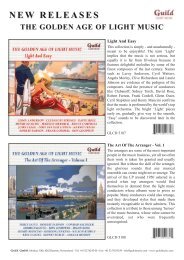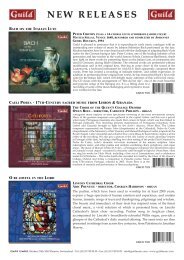GHCD 2372 Guild GmbH Switzerland FRITZ BUSCH and his son (left)
GHCD 2372 Guild GmbH Switzerland FRITZ BUSCH and his son (left)
GHCD 2372 Guild GmbH Switzerland FRITZ BUSCH and his son (left)
Create successful ePaper yourself
Turn your PDF publications into a flip-book with our unique Google optimized e-Paper software.
Fritz Busch’s first visit to Sweden dates from March 1932. Two concerts with the Konsertförenings orkester<br />
were scheduled for t<strong>his</strong> month, on 9 <strong>and</strong> 13 March, the programmes consisting solely of music from the<br />
German-Austrian Classical-Romantic tradition (Mozart, Beethoven, Schubert, Weber, Bruckner). By t<strong>his</strong><br />
time Busch had an increasing schedule as a guest conductor, much to the annoyance of the Dresden State Opera,<br />
whose General Music Director he had been from 1922.<br />
It was to take until 1936 that Busch returned to Stockholm as a conductor – in April of t<strong>his</strong> year he conducted<br />
three concerts, now with a repertoire ranging from a H<strong>and</strong>el Concerto grosso via Berlioz’s Benvenuto Cellini <strong>and</strong><br />
Wagner’s Tannhäuser Overtures to Mahler’s Second Symphony. It was in 1937 that Busch became the orchestra’s<br />
chief conductor (as successor to Václav Talich), <strong>and</strong> remained in t<strong>his</strong> position until 1940.<br />
During the period of three years, Busch conducted more than seventy concerts in Stockholm, with an<br />
unusual breadth of repertoire for him, ranging from a Bach Suite to Ibert’s Saxophone Concerto, from Falla’s<br />
Nights in Spanish Gardens to Elgar’s Enigma Variations, from Henrik Melcher Melchers’ Violin Concerto to an<br />
aria from Debussy’s L’enfant prodigue. Several times he programmed choral-orchestral works such as Verdi’s<br />
Requiem <strong>and</strong> Beethoven’s Ninth (each twice), Brahms’ Deutsches Requiem or the first Act from Die Walküre.<br />
A special focus was on Sc<strong>and</strong>inavian <strong>and</strong> 20th century music – Berwald, Wirén, Sibelius, Stenhammar, Nielsen,<br />
Rosenberg, Pergament, Hallnäs, Liljefors <strong>and</strong> many others featured in <strong>his</strong> Stockholm programmes – sadly hardly<br />
any of their music having survived from the Busch broadcasts.<br />
Fritz Busch conducted Alban Berg’s Violin Concerto (1935) only once ever, <strong>and</strong> t<strong>his</strong> performance happily<br />
has survived (though as the sole item of the concert of 20 April 1938 that also comprised H<strong>and</strong>el’s Concerto<br />
grosso in G major op. 3, No. 3 <strong>and</strong> Beethoven’s Fourth<br />
Symphony). His partner, Louis Krasner (1903–1995),<br />
a former pupil of Carl Flesch, had premiered the work<br />
two years previously in Barcelona <strong>and</strong> was later a<br />
renowned specialist in contemporary music, regularly<br />
performing music by Joseph Achron <strong>and</strong> Alfredo<br />
Casella <strong>and</strong> premiering amongst others Schoenberg’s<br />
Violin Concerto <strong>and</strong> music by Roger Sessions, Henry<br />
Cowell <strong>and</strong> Roy Harris.<br />
On 15 February 1940 Busch conducted the<br />
premiere performance of a new production of Così<br />
fan tutte, directed for stage by <strong>his</strong> <strong>son</strong> Hans Peter,<br />
Louis Krasner<br />
Carl Ebert’s assistant at the Glyndebourne Opera<br />
Festival. The nineteen performances in t<strong>his</strong> sea<strong>son</strong><br />
conducted by Busch (seven more were to follow in<br />
1946 <strong>and</strong> another seven in 1951) were an unanimous<br />
success, Busch being awarded a comm<strong>and</strong>er of the<br />
Royal Vasa Order on 29 February. But the situation<br />
became increasingly threatening – on 9 April the<br />
Buschs had to realize that Norway <strong>and</strong> Denmark had<br />
been occupied by the Nazis. Hence the couple, who<br />
had made Denmark their new home, had to make other arrangements, <strong>and</strong> Grete Busch recalls her husb<strong>and</strong><br />
having been much more hesitant than ever before – annulling existing engagements, having currently no secure<br />
future prospects, <strong>and</strong> even more having to leave <strong>his</strong> two married daughters in Europe, in France <strong>and</strong> Denmark<br />
respectively. Since they were not able to take all their belongings with them, Busch <strong>left</strong> an amount of <strong>his</strong> music<br />
with the orchestra, hence signalling that he would return as soon as possible. For 24 June 1940 the Buschs<br />
had booked flights to Moscow, from where they went, first on the Trans-Siberian Express, then by ship from<br />
Vladivostok to Tsuruga, <strong>and</strong>, after another train ride, again by ship, t<strong>his</strong> time on the elegant MS Kamakura Maru,<br />
from Yokohama to San Francisco, where they arrived on 6 July. From here Fritz Busch wrote to <strong>his</strong> brother Adolf:<br />
“I don’t know whether you feel like I – the more blows of fate you experience, the quieter you grow.” In spite<br />
of Adolf ’s suggestion to come over to New York, the Buschs departed by the end of August for their intended<br />
destination, Buenos Aires, which was to be the centre of their life from 1940 to 1945.<br />
Busch returned to Stockholm soon after the Second World War, <strong>his</strong> first concert with the Konsertförenings<br />
orkester taking place on 29 September 1946. It is from t<strong>his</strong> concert that the final item of the current CD has<br />
survived on tape. Franz Berwald was a composer Busch several times turned to <strong>and</strong> it is with t<strong>his</strong> composer’s<br />
Sinfonie sérieuse that Busch’s most substantial rehearsal sequences (in fact the total of three full-size rehearsals<br />
covering close on two <strong>and</strong> a half hours) have survived. 1 Busch programmed the overture to Estrella di Soria at<br />
least five times (including in Uppsala <strong>and</strong> Malmö), <strong>and</strong> another recording of the overture in a performance from<br />
the Carnegie Hall from 11 April 1949 has survived in the Swedish Radio Archive. 2<br />
After in 1947 Busch had returned to Stockholm solely as an opera conductor (of Verdi’s Macbeth, in eight<br />
performances), audiences had to wait until 30 November 1949 for Busch to return to Sweden; t<strong>his</strong> very concert<br />
was repeated on 4 December <strong>and</strong> on t<strong>his</strong> occasion recorded for broadcast. T<strong>his</strong> time the programme was even<br />
more varied, <strong>and</strong> its second half has survived on tape. The concert opened with Verdi’s Luisa Miller overture<br />
4 5

















